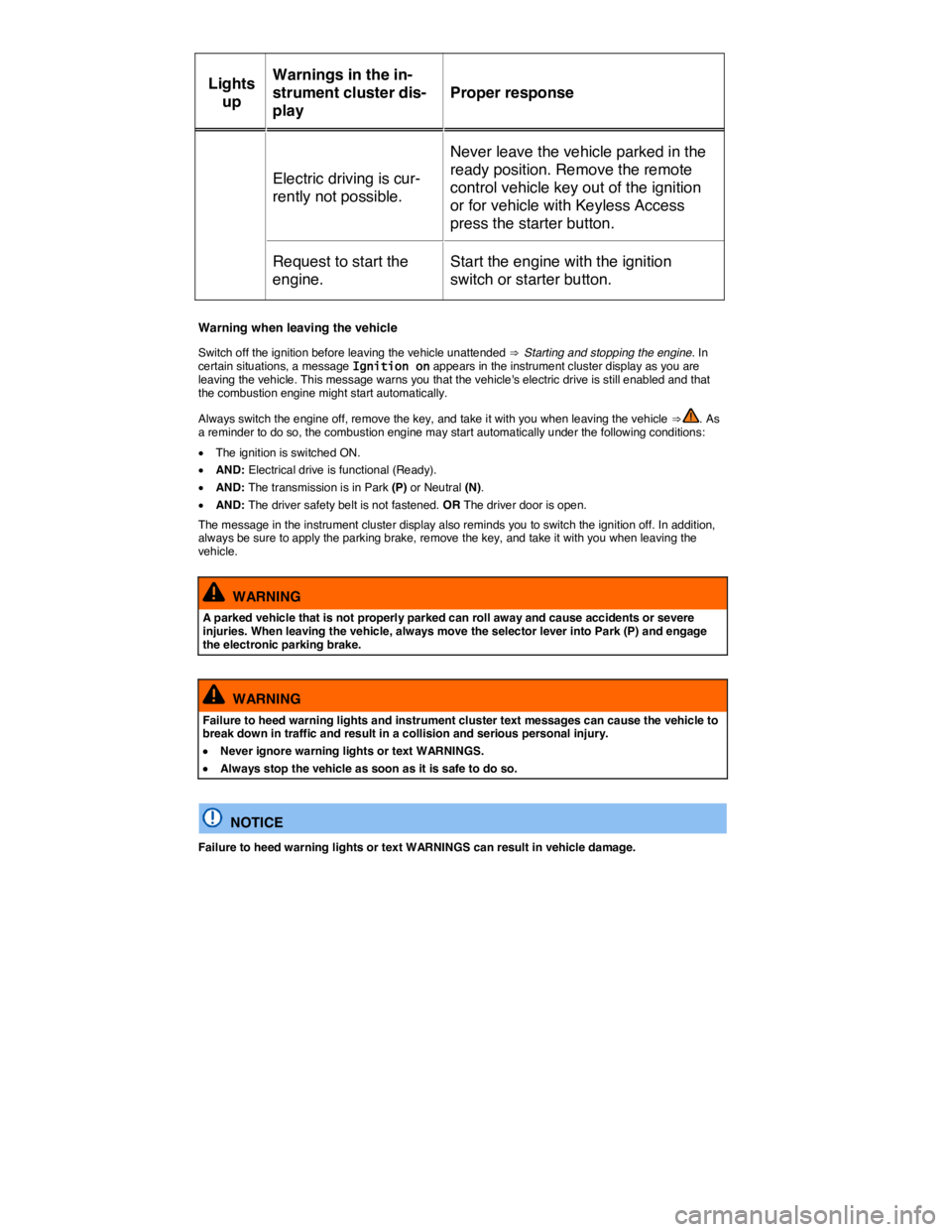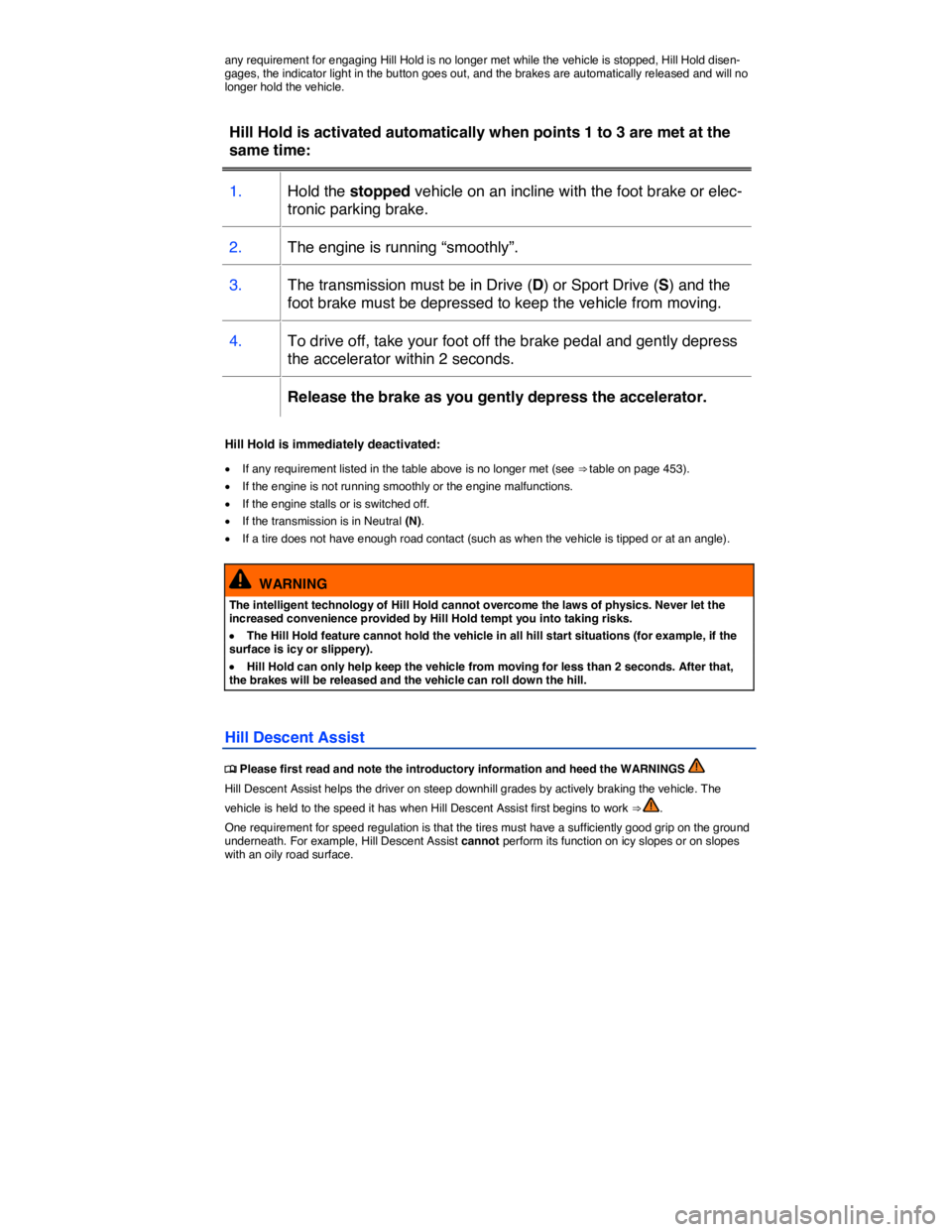2017 VOLKSWAGEN TOUAREG brake
[x] Cancel search: brakePage 432 of 684

If the driver door is opened before the ignition is switched off, the electronic steering column lock is activated only after the vehicle has been locked with the vehicle key or via the sensor in the door handle.
Power steering
Power steering automatically adjusts to driving speed, steering torque, and the steering angle of the wheels. Power steering works only when the engine is running.
If power steering is reduced or lost completely, it will be much harder to steer and control the vehicle.
Counter-steering assistance
Counter-steering assistance is part of Electronic Stability Control (ESC). This feature makes it easier for the driver to control the vehicle in difficult situations. For example, if you have to brake hard on a surface that provides uneven traction, the vehicle could pull to the right or left. ESC detects this situa-
tion and helps the driver counter-steer with additional steering power ⇒ .
WARNING
The counter-steering assistance in ESC can do no more than help the driver steer in difficult situations. The driver must still control the vehicle. The vehicle does not steer by itself with this feature!
NOTICE
If the ignition is off, the steering column lock will engage and the vehicle cannot be steered. For this reason, you must leave the ignition on when going through an automatic car wash, for example, so that the wheels will still steer.
Page 437 of 684

Lights
up
Warnings in the in-
strument cluster dis-
play
Proper response
Electric driving is cur-
rently not possible.
Never leave the vehicle parked in the
ready position. Remove the remote
control vehicle key out of the ignition
or for vehicle with Keyless Access
press the starter button.
Request to start the
engine.
Start the engine with the ignition
switch or starter button.
Warning when leaving the vehicle
Switch off the ignition before leaving the vehicle unattended ⇒ Starting and stopping the engine. In certain situations, a message Ignition on appears in the instrument cluster display as you are leaving the vehicle. This message warns you that the vehicle's electric drive is still enabled and that the combustion engine might start automatically.
Always switch the engine off, remove the key, and take it with you when leaving the vehicle ⇒ . As a reminder to do so, the combustion engine may start automatically under the following conditions:
�x The ignition is switched ON.
�x AND: Electrical drive is functional (Ready).
�x AND: The transmission is in Park (P) or Neutral (N).
�x AND: The driver safety belt is not fastened. OR The driver door is open.
The message in the instrument cluster display also reminds you to switch the ignition off. In addition, always be sure to apply the parking brake, remove the key, and take it with you when leaving the vehicle.
WARNING
A parked vehicle that is not properly parked can roll away and cause accidents or severe injuries. When leaving the vehicle, always move the selector lever into Park (P) and engage the electronic parking brake.
WARNING
Failure to heed warning lights and instrument cluster text messages can cause the vehicle to break down in traffic and result in a collision and serious personal injury.
�x Never ignore warning lights or text WARNINGS.
�x Always stop the vehicle as soon as it is safe to do so.
NOTICE
Failure to heed warning lights or text WARNINGS can result in vehicle damage.
Page 439 of 684

Driving situa-
tions
Requirements and
conditions Vehicle behavior
Braking energy
regeneration
(Recuperation).
– Early and even brak-
ing with short brake
pedal travel.
The vehicle is braked by the
electric motor. Most of the
kinetic energy is then won
back and can be stored in the
form of electrical energy in the
high-voltage battery.
Driving in city
traffic.
– Selection of a moder-
ate speed.
Driving in fully electric mode at
this level is possible only with
a speed of up to approximately
50 km/h (31 mph).
– Avoid full acceleration.
The fuel consumption is re-
duced with moderate accelera-
tion due to higher efficiency of
the combustion engine and
driving in fully electric mode is
possible.
– Careful use of �%�
Page 443 of 684

This depends on vehicle conditions of the hybrid drive system is normal and is designed to save fuel. The power steering and the braking assistance systems remain active. In certain situations it may be necessary for the system to start the combustion engine even when the vehicle is not moving. With prolonged driving in traffic jams, the combustion engine will be switched on and off to charge the high-voltage battery for the following start-stop phase.
Sailing
If the accelerator is not depressed and the lever is in Drive (D), the internal combustion engine is switched off even at higher speeds. The vehicle then decelerates slower than conventional vehicles.
This feature can be used to help reduce fuel consumption when you keep traffic conditions in mind and can anticipate the vehicles power requirements. Even in this case, the rev counter in the instru-ment cluster displays zero engine speed (0 engine revolutions). The instrument cluster powermeter shows zero.
Brake energy regeneration (Recuperation/charge)
When the vehicle brakes, the electrical energy is generated by the electric motor, which works as an alternator and charges the high-voltage battery. The same thing occurs while the vehicle is coasting to a stop or driving downhill.
Energy regeneration is shown in the instrument cluster display or on the Infotainment System screen. The combustion engine may be switched off automatically in this situation. The instrument cluster powermeter registers below zero.
When the high voltage battery is fully charged, there is no brake energy recuperation, and therefore no engine braking. Recuperation and engine braking are also automatically reduced if the vehicle detects that the road conditions do not permit sufficient contact between the wheels and the road surface.
Automatic starting - combustion engine
The combustion engine is started automatically in a number of situations.
�x Engine temperature is too low.
�x Catalytic converter temperature is too low.
�x High-voltage battery being charged at high rate when decelerating. The high-voltage battery can-not absorb any more energy and for this reason the electric motor cannot brake the vehicle. The combustion engine comes on to help slow the vehicle down (engine brake).
�x Engine hood is open.
�x Leaving the vehicle when the electric motor is still “live”. The status of the electric motor is not always obvious, particularly when the combustion engine is not running. The combustion engine will therefore start if the driver's safety belt is unlatched or the driver's door is opened when the transmis-
sion is in Park (P) or Neutral (N) ⇒ Warning when leaving the vehicle.
Page 449 of 684

any requirement for engaging Hill Hold is no longer met while the vehicle is stopped, Hill Hold disen-gages, the indicator light in the button goes out, and the brakes are automatically released and will no longer hold the vehicle.
Hill Hold is activated automatically when points 1 to 3 are met at the
same time:
1. Hold the stopped vehicle on an incline with the foot brake or elec-
tronic parking brake.
2. The engine is running “smoothly”.
3. The transmission must be in Drive (D) or Sport Drive (S) and the
foot brake must be depressed to keep the vehicle from moving.
4. To drive off, take your foot off the brake pedal and gently depress
the accelerator within 2 seconds.
Release the brake as you gently depress the accelerator.
Hill Hold is immediately deactivated:
�x If any requirement listed in the table above is no longer met (see ⇒ table on page 453).
�x If the engine is not running smoothly or the engine malfunctions.
�x If the engine stalls or is switched off.
�x If the transmission is in Neutral (N).
�x If a tire does not have enough road contact (such as when the vehicle is tipped or at an angle).
WARNING
The intelligent technology of Hill Hold cannot overcome the laws of physics. Never let the increased convenience provided by Hill Hold tempt you into taking risks.
�x The Hill Hold feature cannot hold the vehicle in all hill start situations (for example, if the surface is icy or slippery).
�x Hill Hold can only help keep the vehicle from moving for less than 2 seconds. After that, the brakes will be released and the vehicle can roll down the hill.
Hill Descent Assist
�
Page 450 of 684

An indicator light �k comes on in the instrument cluster display whenever Hill Descent Assist is ena-bled. The indicator light blinks when Hill Descent Assist is regulating the brakes.
Hill Descent Assist is always enabled, but only regulates the brakes when certain requirements are met.
Hill Descent Assist regulates automatically:
�x If the vehicle is in off-road mode and the indicator light �k is on.
�x And: If your speed is under 18 mph (30 km/h).
�x And: If the downhill grade is 10 % or steeper.
�x And: If you neither accelerate nor apply the brakes.
�x And: If the vehicle's engine is running.
If you accelerate or step on the brake when Hill Descent Assist is operating, the feature switches off. Hill Descent Assist begins regulating speed again the next time the requirements are met.
Hill Descent Assist does not regulate speed:
�x On downhill grades of less than 10 %.
�x OR: At speeds over 18 mph (30 km/h).
�x OR: If the driver brakes or accelerates.
WARNING
Always be ready to apply the brakes. Otherwise accidents and injuries can occur.
�x Hill Descent Assist is merely a driving aid and cannot always slow the vehicle down enough under on downhill grades.
�x The vehicle may pick up speed despite the use of Hill Descent Assist.
The Hill Descent Assist also works when you are backing down a hill.
Page 454 of 684

WARNING
Always remember that the Adaptive Cruise Control has limits – Using Adaptive Cruise Con-trol when it is not possible to drive safely at a constant speed can be dangerous and can lead to an accident and serious personal injury.
�x Adaptive Cruise Control will not slow the vehicle down or maintain the set distance when you drive towards an obstacle or something on or near the road that is not moving, such as vehicles stopped in a traffic jam, a stalled or disabled vehicle.
�x Always adjust your speed and the distance you keep between you and the vehicles ahead of you to the road, traffic, weather, and visibility conditions.
�x Never use Adaptive Cruise Control on steep, winding, or slippery roads (such gravel roads, wet roads, or snowy or icy roads) or on roads with standing water.
�x Never use Adaptive Cruise Control when driving in heavy or varying stop-and-go traffic.
�x Never use Adaptive Cruise Control when driving off-road or on unpaved roads.
�x Always remember that the Adaptive Cruise Control cannot detect a vehicle that is driving towards you in your traffic lane and that it cannot detect narrow vehicles such as motorcy-cles and bicycles.
�x Never follow a vehicle so closely that you cannot stop your vehicle safely. The Adaptive Cruise Control cannot slow or brake the vehicle safely when you follow another vehicle too closely. Always remember that the Adaptive Cruise Control has a braking power that is only about 30% of the vehicle's maximum braking ability, under certain circumstances the auto-matic braking function cannot bring the vehicle to a stop in time.
�x Always turn off Adaptive Cruise Control when entering turn lanes, exit lanes and construc-tion zones or in similar situations because the vehicle will automatically accelerate to the stored speed when the road ahead is clear.
�x To help prevent unintended operation of Adaptive Cruise Control, switch the system off when it is not being used.
�x It is dangerous to use the Resume feature when the previously set speed is too high for the existing road, traffic, or weather conditions.
�x When traveling downhill, the Adaptive Cruise Control may not be able to maintain a con-stant speed. The vehicle will speed up because of its own weight. Downshift and/or use the foot brake to slow the vehicle.
�x Never allow the closing speed between you and other vehicles to be so high that the Adaptive Cruise Control may not be able to slow your vehicle safely. If closing speed is too high, you must apply the brakes yourself to reduce the risk of a rear-end crash.
�x If a driver intervention warning appears in the instrument cluster display, immediately takeover the control of the brake and gas pedals and low down the vehicle or bring it to stop when necessary and according to the traffic situation.
�x If a Forward Collision Warning system (Front Assist) collision warning appears in the instrument cluster display, immediately takeover the control of the brake and gas pedals and low down the vehicle or bring it to stop when necessary and according to the traffic situation.
�x Always be prepared to takeover the control of the brake and the gas pedal in every situa-tion.
NOTICE
If you suspect that ACC and the Forward Collision Warning system (Front Assist) don't work properly or the sensors are damaged, switch off ACC immediately.
�x Go see an authorized Volkswagen dealer or Volkswagen Service Facility for assistance and have the ACC system checked.
Page 464 of 684

WARNING
Improper use of the Adaptive Cruise Control can cause collisions, other accidents and seri-ous personal injury.
�x Always remember that the Adaptive Cruise Control has limits – it will not slow the vehicle down or maintain the set distance when you drive towards an obstacle or something on or near the road that is not moving, such as vehicles stopped in a traffic jam, a stalled or disa-bled vehicle.
�x Always remember that the Adaptive Cruise Control cannot detect a vehicle that is driving towards you in your traffic lane and that it cannot detect narrow vehicles such as motorcy-cles and bicycles.
�x Never drive at speeds that are too fast for traffic, road and weather conditions.
�x Never follow a vehicle so closely that you cannot stop your vehicle safely. The Adaptive Cruise Control cannot slow or brake the vehicle safely when you follow another vehicle too closely. Always remember that the Adaptive Cruise Control has a braking power that is only about 30% of the vehicle's maximum braking ability, the automatic braking function cannot bring the vehicle to a stop.
�x Never use Adaptive Cruise Control when you cannot drive safely at a steady speed, in-cluding on city streets, on winding roads or when road conditions are poor (for example, on ice, gravel, in fog, heavy rain or on wet roads that increase the risk of hydroplaning).
�x The radar sensor's vision can be reduced by rain, snow and heavy road spray. These and similar conditions can prevent vehicles up ahead from being accurately detected and in some cases they may not be detected at all. Do not use ACC when the radar sensors cannot accu-rately detect vehicles moving ahead of you in traffic.
�x Always turn off Adaptive Cruise Control when entering turn lanes, exit lanes and construc-tion zones or in similar situations because the vehicle will automatically accelerate to the stored speed when the road ahead is clear.
�x Never rest your foot on the accelerator pedal, especially when the Adaptive Cruise Control is being used because doing so will override the braking function.
�x Always pay attention to traffic, especially when Adaptive Cruise Control is switched on.
�x Always maintain a safe speed and distance between your vehicle and other vehicles while considering the traffic situation. This is the duty of the driver. Adaptive Cruise Control is merely an aid to the driver.
�x To prevent unintended operation, always switch ACC off when it is not being used.
�x It is dangerous to use the “Resume” feature when the previously set speed is too high for existing road, traffic or weather conditions.
�x Always select a speed and distance to traffic ahead that is safe and appropriate under the prevailing traffic, road, weather and lighting conditions.
�x Never allow the closing speed between you and other vehicles to be so high that the Adaptive Cruise Control may not be able to slow your vehicle safely. If closing speed is too high, you must apply the brakes yourself to reduce the risk of a rear-end crash.
NOTICE
When the vehicle is driving at speeds lower than 20 mph (30 km/h) and the �3�%�4 button is pressed or the lever is moved to �2�%�3�5�-�%, the vehicle will be accelerated to the lowest possible speed that can be set in ACC of 20 mph (30 km/h)
The stored speed is canceled when the ignition or the ACC is switched off.